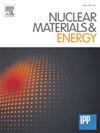Evolution of elemental depth profiles on co-deposited layers at the divertor region of the WEST tokamak during its Phase 1 operations
IF 2.7
2区 物理与天体物理
Q1 NUCLEAR SCIENCE & TECHNOLOGY
引用次数: 0
Abstract
We discuss detailed elemental, compositional, and structural properties of co-deposited layers formed on the special marker tiles at the divertor region of the WEST tokamak during its Phase 1 (2016–2021) plasma operations. The main new aspects are applying high depth and mass resolution, provided by a combination of state-of-the-art local analysis techniques, throughout the entire surface deposit and cross correlating the obtained results with published ones. We also show that proper comparison of the different data sets requires deconvoluting them with several experimental parameters, most importantly the lateral and depth resolutions as well as the analysis volume. The analyses reveal that the thickest deposits are formed towards the end of Phase 1, and the change is particularly noticeable after the C4 campaign with the longest exposure time and the largest number of boronizations carried out. Thin deposits (thickness up to 1–2 μm) are found on several poloidal regions of the analysed tiles, and they exhibit a clear sandwich-type of structure consisting of distinct B, C, O, and/or W-rich sublayers together with metallic impurities. Close to the inner strike point, thick deposits are measured (thickness several tens of micrometres) and they show complex, stratified structures, however, the same sublayer structure as for the thin deposits can still be recognized. On the thin deposits, the very surface is rich in B while for the thick deposits W dominates the topmost surface layers in the latter stages of Phase 1. For all the analysed samples, the superficial B and W concentrations are on average 10–30 at.% in addition to which high oxygen levels up to 15–40 at.% are measured. In the erosion-dominated regions, deposits can be observed but only in the microscopic scale inside recessed valleys, up to thicknesses of several micrometres. A dynamical erosion–deposition picture for the surface layers is confirmed, further contributing to their structure and composition.
西托卡马克一期工程引水区共沉积层元素深度剖面的演化
我们详细讨论了在西托卡马克第一阶段(2016-2021)等离子体运行期间,在其转向器区域的特殊标记瓦上形成的共沉积层的元素、组成和结构特性。主要的新方面是在整个地表沉积物中应用高深度和高质量分辨率,这是由最先进的本地分析技术相结合提供的,并将获得的结果与已发表的结果相互关联。我们还表明,不同数据集的适当比较需要用几个实验参数对它们进行反卷积,最重要的是横向和深度分辨率以及分析体积。分析表明,在第1阶段结束时形成了最厚的沉积物,并且在暴露时间最长、硼化次数最多的C4运动之后,这种变化尤为明显。在分析瓦片的几个极向区域发现了薄沉积物(厚度可达1-2 μm),它们呈现出清晰的三明治型结构,由不同的B、C、O和/或w富亚层以及金属杂质组成。在靠近内走向点处,可测到厚度达数十微米的厚层沉积,其构造复杂,呈层状,但仍可识别出与薄层沉积相同的亚层结构。在较薄的矿床中,最表层富含B,而在较厚的矿床中,在第1阶段的后期,W在最表层占主导地位。对于所有分析的样品,表面的B和W浓度平均为10 - 30at。此外,高氧含量可达15-40℃。%被测量。在侵蚀为主的地区,可以观察到沉积物,但仅在凹陷山谷内的微观尺度上,厚度可达几微米。确认了表层的动态侵蚀-沉积图,进一步有助于了解其结构和组成。
本文章由计算机程序翻译,如有差异,请以英文原文为准。
求助全文
约1分钟内获得全文
求助全文
来源期刊

Nuclear Materials and Energy
Materials Science-Materials Science (miscellaneous)
CiteScore
3.70
自引率
15.40%
发文量
175
审稿时长
20 weeks
期刊介绍:
The open-access journal Nuclear Materials and Energy is devoted to the growing field of research for material application in the production of nuclear energy. Nuclear Materials and Energy publishes original research articles of up to 6 pages in length.
 求助内容:
求助内容: 应助结果提醒方式:
应助结果提醒方式:


